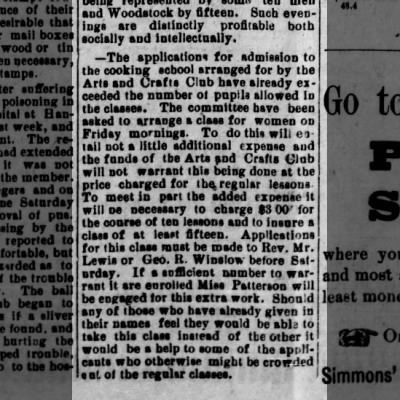Woodstock's Arts and Craft Club
By Jennie Shurtleff
In the late 19th and early 20th centuries, as people began to have more leisure time and discretionary income, they also began to search for ways to expand their knowledge and improve their lives. This desire manifested itself in a number of ways. Reform and advocacy-oriented groups arose, such as Improvement Societies and Grange organizations, and new clubs were formed that provided not only a source of socialization for people living in remote areas, but also a chance to learn new skills.
In Woodstock, one of the most popular groups was called the Arts and Crafts Club. For a nominal fee, both children and adults could take classes on a wide variety of topics that included carpentry, basket weaving, chair caning, drawing, wood carving, electrical work, pottery, and more. Instructors and lectures featured such well-known names as artist Arthur Wilder and illustrator/author Anne Bosworth Greene.



The Woodstock Craft Shop which was original located in the front part of the “Dana Building” located at 24 Elm Street. ©Woodstock History Center
Over time, this club opened a store in the Dana Building, located at 24 Elm Street, that was known as the “Woodstock Craft Shop.” This store sold juried, high-quality handcrafts that were designed for the tourist market. While undoubtedly providing a creative outlet for some, for others – particularly those in remote areas - it provided a market for their handcrafts and afforded them an avenue to earn extra money.
A Vermont Standard article written on April 20, 1916 states:
“The Craft Shop is a philanthropy. It was organized to help men and woman add to their limited incomes by the making of useful and beautiful things. The articles are sold on commission and this commission is used to meet the necessary expenses of the shop, such as postage, stationery, wrapping, paper and so on, and then it helps to pay the rent and lighting of the old store, which the Arts and Crafts uses for its headquarters. Thus the Craft shops helps to make possible a place where the classes in carpentry and drawing and such other ones as may be conducted through the winter months, may meet…”
“There are a number of consignors who find life a difficult thing, and the money they earn at the Shop is an important element in the meeting of their expenses. Here is a girl working her way through school. She makes some little things and sells them through the Shop and so helps to buy books and clothes. Here is a woman with a drunken husband and a large family of children. She works at night and makes articles to shell at the Shop. A family is started and have begun to sell their furniture in order to live. The Shop helps them sell things which they can make and they are encourage and finally are gotten onto their feet. There are families living on hill farms where the stones do not yield abundant harvests of grain, and the women crochet, braid rugs and knit. The Shop helps them find a market for the product of their hands. Other consignors have had sickness, sorrow, hospital experiences and need to get money in order to help pay bills. The women who manage the Shop have never wanted it to be a money-making affair. They want to meet all legitimate expenses but their whole aim is to maintain a philanthrophy which shall help a lot of deserving people and create a love for beautiful things and so bring to those who work and those who buy a new joy and delight in the things made by human hands and planned for by human brains.”
The article goes on to say:
“The Shop does not enter into competition with any store, for it is absolutely dependent for its sales on the transient guests who come to Woodstock. The people at the Inn and the automobile parties. These people are not here to buy groceries and clothing, and such things, but they do buy the hand-made things at the Shop, for many of them are interested in helping folks in this way and they are delighted to find well-made and beautiful handiwork.”
The Arts and Crafts Club may have started out as a local club, but soon its reach expanded. By 1921, the breadth of those consigning their work at the store included artists from all over Vermont, including some pieces done by the “crippled children of Vermont.” These pieces were met with what was described as a “most generous response… by many kindly people who have been interested in this work.”
Eventually, the shop changed its location from Harold Dana’s building on Elm Street to a shed by the Canfield home on Rose Hill. With the change of location, it appears that the merchandise sold in the shop also broadened to include hand-embroidered linens from the Near East that the Club received through the Near East committee and the Quaker Relief Committee, as well as hats from the Philippine Islands.
Groups such as Woodstock’s Art and Culture Club are reflective of the times in which they were created. During the late 1800s and early 1900s, there was not only an intense spirit of reform and desire to make the world a better place, but there was also a belief in grassroots organizations. If people wanted to learn new skills, broaden their social circle, or find ways to help marginalized people, they came up with creative, grassroots solutions. Sometimes (as in the case of the Art and Culture Club) these initiatives addressed multiple problems with a single program.
As with the case of most successful initiatives, there are usually a few talented, dedicated, people at the center of the movement. These people are not only able to inspire others, but also willing get involved themselves. That certainly appears to have been the case with the Arts and Culture Club that had the Canfields at the center of the movement.
Advertisement for the Craft Shop from January 3, 1918, Vermont Standard.
Mr. Canfield was a Reverend at the Universalist Unitarian Church. His wife, Mary Grace, authored the book Valley of the Kedron. Both were outspoken and avid supporters of many liberal causes, such as the right of women to vote and their opposition to violence and war. Given such humanistic sentiments, it is not surprising that they should find themselves drawn to a cause such as the Arts and Crafts Club that promoted community, education, and helping people to help themselves.
Reverend and Mary Grace Canfield in their home on Rose Hill. © Woodstock History Center.



